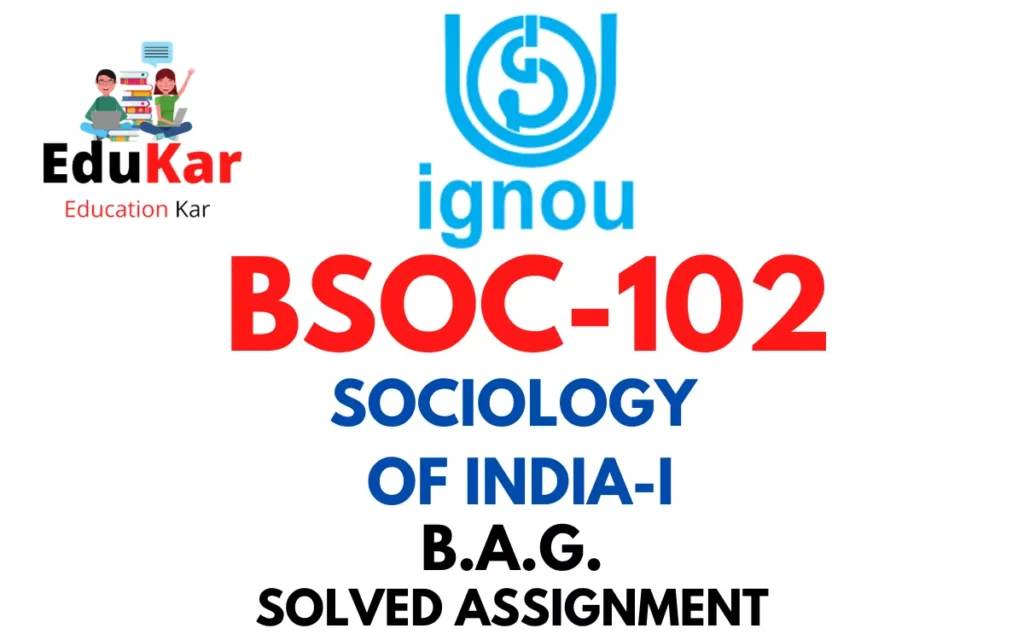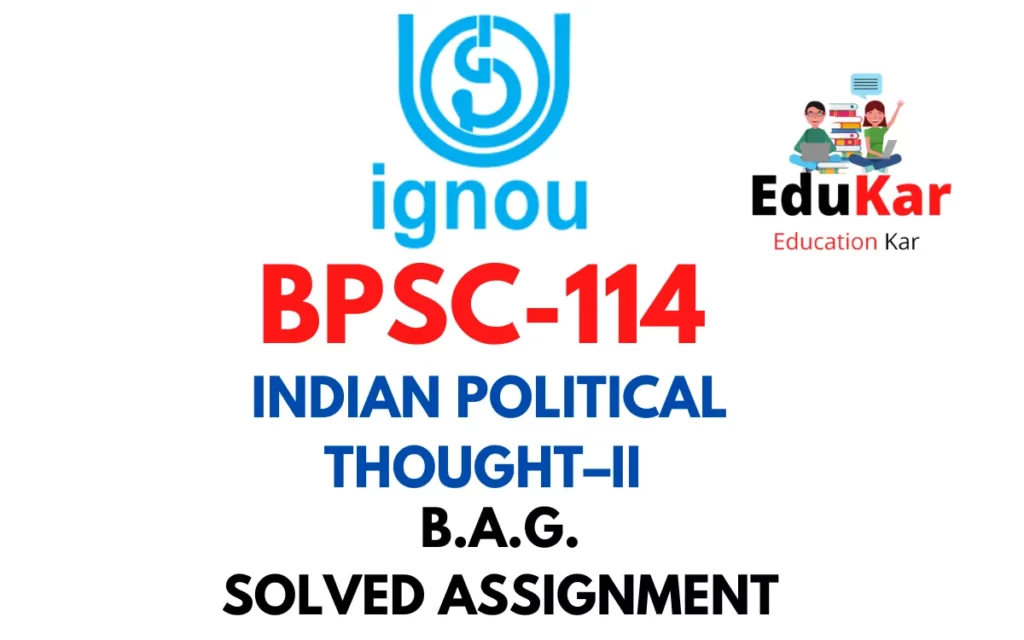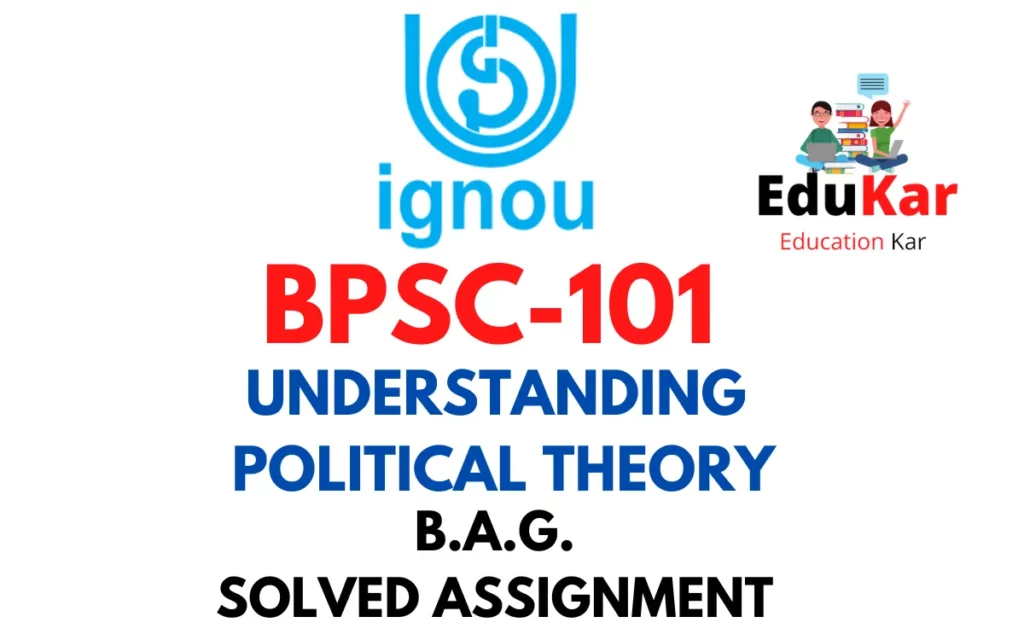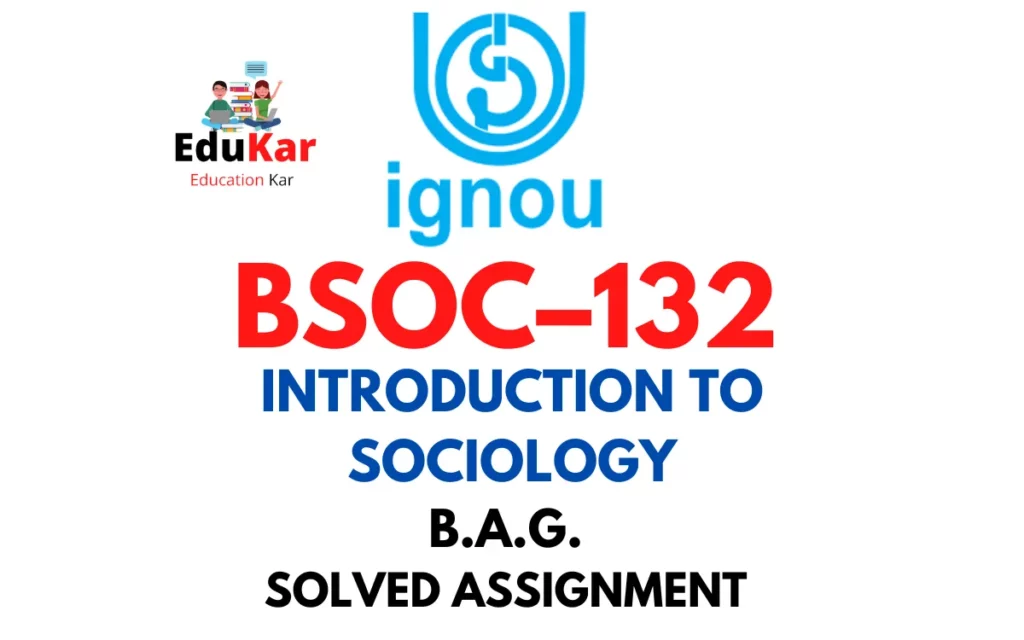Contents
- 1 Assignment-I
- 2 Answer the following in about 500 words each.
- 3 1. Trace the basic concepts of the Brahmanic tradition.
- 4 2. Examine the limitations of the Sramanic tradition.
- 5 Assignment-II
- 6 Answer the following questions in about 250 words each.
- 7 1. Write a note on the Islamic traditions in Indian thought.
- 8 2. Trace the impact of the Bhakti tradition.
- 9 3. Elaborate upon Ved Vyas and ‘Mahabharat’
- 10 Assignment-III
- 11 Answer the following questions in about 100 words each.
- 12 1. Describe ‘Rajdharma’.
- 13 2. Discuss Kautilya’s views on the state.
- 14 3. Trace the idea of chakravartin and the state as an instrument of Dhamma.
- 15 4. What is the theory of kingship as propounded by Zia-ul-Barni? Elaborate.
- 16 5. Examine Abul Fazal’s views on sovereignty and social contract.
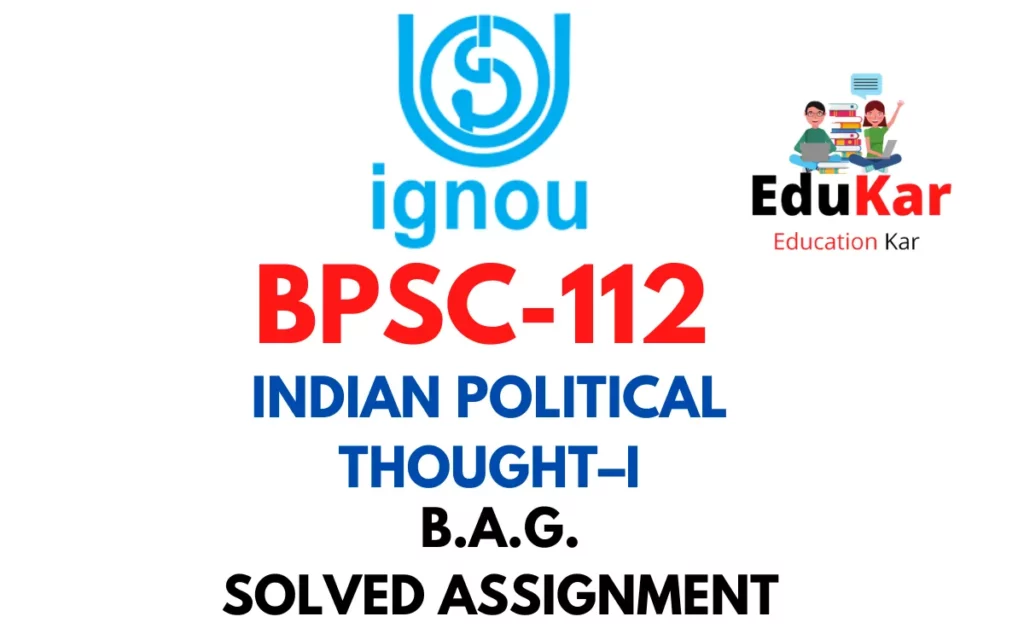
| Title | BPSC-112: IGNOU BAG Solved Assignment 2022-2023 |
| University | IGNOU |
| Degree | Bachelor Degree Programme |
| Course Code | BPSC-112 |
| Course Name | INDIAN POLITICAL THOUGHT–I |
| Programme Name | Bachelor of Arts (General) |
| Programme Code | BAG |
| Total Marks | 100 |
| Year | 2022-2023 |
| Language | English |
| Assignment Code | BPSC-112/ASST/TMA/2022-23 |
| Last Date for Submission of Assignment: | For June Examination: 31st April For December Examination: 30th September |

Assignment-I
Answer the following in about 500 words each.
1. Trace the basic concepts of the Brahmanic tradition.
Ans: The Brahmanic tradition is an ancient system of Hinduism that developed in India over thousands of years. It is based on the teachings of the Vedas, which are considered the oldest and most sacred texts in Hinduism. The Brahmanic tradition is focused on the concept of Brahman, which is the ultimate reality that underlies all of existence.
At its core, the Brahmanic tradition teaches that the universe is a manifestation of Brahman, and that all beings are ultimately one with Brahman. This concept is known as monism, or the belief in the unity of all things. The Brahmanic tradition also teaches that the ultimate goal of life is to realize this oneness and achieve liberation from the cycle of birth and death, known as samsara.
One of the key practices of the Brahmanic tradition is the performance of yajnas, or Vedic sacrifices. These are complex rituals that involve the offering of food, fire, and other substances to the gods in order to maintain the order of the universe and ensure the well-being of all beings. Yajnas are seen as a way to express devotion to the gods and to align one’s actions with the cosmic order.
Another important aspect of the Brahmanic tradition is the concept of dharma, which is the cosmic law that governs all beings and their actions. Dharma is seen as a way to maintain harmony and balance in the universe, and it is based on the idea of fulfilling one’s duties and responsibilities in accordance with one’s caste and stage of life. The Brahmanic tradition also teaches the concept of karma, which is the idea that all actions have consequences, and that these consequences determine the course of one’s life and future rebirths.
Finally, the Brahmanic tradition also emphasizes the importance of meditation and self-realization. Through meditation and other spiritual practices, individuals can gain insight into the true nature of reality and achieve a state of inner peace and liberation from the cycle of samsara. This state is known as moksha, and it is the ultimate goal of the Brahmanic tradition.
2. Examine the limitations of the Sramanic tradition.
Ans: The Sramanic tradition, which emerged in ancient India around the same time as Hinduism, Jainism, and Buddhism, is characterized by its emphasis on asceticism, self-discipline, and spiritual liberation. Despite its long history and the many important thinkers and leaders associated with it, the Sramanic tradition has some notable limitations that have prevented it from achieving greater success and influence.
One of the main limitations of the Sramanic tradition is its narrow focus on individual spiritual liberation to the exclusion of broader social and political issues. Many Sramanic teachings emphasize the importance of individual detachment from material possessions and social roles, which can lead to a sense of apathy or disengagement from the world around them. While some Sramanic traditions have been active in social and political movements, such as Jainism’s opposition to violence and Buddhism’s promotion of peace, they have often been marginalized within their societies and have not been able to effect significant change.
Another limitation of the Sramanic tradition is its rejection of Vedic tradition and the caste system. While these rejections have been important for promoting equality and challenging social hierarchies, they have also resulted in a lack of continuity and integration with broader social structures. Sramanic communities have often been isolated from mainstream society and have struggled to build enduring institutions and organizations that can provide for their needs and support their spiritual practices.
In addition, the Sramanic tradition has been criticized for its emphasis on extreme asceticism and self-denial, which can lead to physical and mental harm. While some Sramanic practices, such as meditation and yoga, have been found to have health benefits, others, such as fasting and self-mortification, can be dangerous and counterproductive. There have been cases of Sramanic practitioners causing harm to themselves or others, either intentionally or unintentionally, as a result of their extreme practices.
Furthermore, the Sramanic tradition has been limited by its lack of a unified doctrine or institutional structure. Unlike Hinduism, which has a complex hierarchy of priests and scholars, and Buddhism, which has a well-defined monastic order, the Sramanic tradition has been characterized by a diversity of practices and beliefs, with little centralized authority or organization. This has made it difficult for the tradition to develop a coherent identity or to present a unified front in the face of external pressures or challenges.
Finally, the Sramanic tradition has been limited by its historical and cultural context. Many Sramanic teachings were developed in response to the social and religious conditions of ancient India, and may not be as relevant or effective in other contexts. The emphasis on asceticism and renunciation may not resonate with people in more materialistic or consumer-oriented societies, and the rejection of established religious traditions may be seen as a threat to social stability or cultural continuity.
Despite these limitations, the Sramanic tradition has had a significant impact on Indian culture and spirituality, and has influenced the development of other religious and philosophical traditions around the world. The tradition’s emphasis on self-discipline, nonviolence, and spiritual liberation has inspired many people to seek a deeper understanding of themselves and the world around them. However, in order to continue to be relevant and effective in the modern world, the Sramanic tradition will need to address these limitations and adapt to changing social and cultural contexts.
Assignment-II
Answer the following questions in about 250 words each.
1. Write a note on the Islamic traditions in Indian thought.
Ans: Islamic traditions have had a significant impact on Indian thought and culture, especially in the areas of religion, literature, and architecture. Islam was introduced to India in the 7th century, and over time, the religion and its cultural practices became deeply rooted in the country.
In terms of religion, the Islamic influence can be seen in the Sufi movement, which emphasized the importance of love and devotion to God. Sufism was a reaction to the formalism and legalism of mainstream Islam, and it resonated with Indian spiritual seekers. The Chishti order of Sufism, in particular, gained a large following in India, and its teachings had a profound impact on Indian culture.
Islamic traditions have also left their mark on Indian literature. Persian, which was the language of the Mughal court, became an important literary language in India, and many works of literature were translated into it. This led to a fusion of Indian and Persian literary styles, resulting in the creation of a unique Indian-Persian literature. One of the most famous examples of this is the epic poem “Padmavat” by Malik Muhammad Jayasi, which tells the story of a Rajput queen who chooses death over dishonor at the hands of a Muslim ruler.
Finally, Islamic architecture has had a significant impact on Indian culture. The Mughals, who ruled over India from the 16th to the 19th century, were responsible for many of India’s most iconic architectural landmarks, including the Taj Mahal and the Red Fort. These structures reflect a fusion of Indian and Islamic architectural styles, resulting in a unique form of Indo-Islamic architecture.
2. Trace the impact of the Bhakti tradition.
Ans: The Bhakti tradition refers to a movement in Indian religion that emerged between the 6th and 17th centuries CE. It emphasized devotion to a personal god or goddess, as opposed to the ritualistic practices of mainstream Hinduism, Buddhism, and Jainism. This movement had a significant impact on Indian society, culture, and politics, and its influence can still be seen today.
One of the most significant impacts of the Bhakti tradition was its role in promoting social equality and challenging the caste system. Many Bhakti saints and poets came from lower castes and advocated for social justice and equality. They rejected the idea that one’s social status determined their spiritual worth and challenged the Brahminical orthodoxy that had dominated Indian society for centuries.
Another impact of the Bhakti tradition was its contribution to the development of regional languages and literature. Bhakti saints and poets wrote in their local vernaculars, rather than Sanskrit, which was the language of the elite. This helped to democratize literature and make it accessible to a wider audience, while also contributing to the development of literary traditions in languages such as Hindi, Tamil, Telugu, and Bengali.
The Bhakti tradition also had a significant impact on the arts, particularly music and dance. Bhakti poetry was often set to music and performed in public, creating a popular form of devotional music that was accessible to people of all castes and classes. This helped to break down social barriers and foster a sense of community and shared identity.
3. Elaborate upon Ved Vyas and ‘Mahabharat’
Ans: Ved Vyas is a revered figure in Hinduism who is best known for his role in compiling the Vedas, the most ancient and sacred texts of Hinduism, and for writing the epic poem ‘Mahabharat’. He is considered to be one of the greatest sages of ancient India and is believed to have lived between the 4th and 3rd centuries BCE.
The ‘Mahabharat’ is an epic poem that tells the story of a war between two groups of cousins, the Pandavas and the Kauravas. The poem is divided into 18 books and contains over 100,000 couplets, making it one of the longest poems in the world. It is a work of extraordinary literary and philosophical complexity and is considered to be one of the most important texts in Hinduism.
Ved Vyas is credited with writing the ‘Mahabharat’, but the poem is actually a compilation of stories and legends that had been passed down orally for centuries. Ved Vyas is said to have organized these stories and added his own philosophical insights and interpretations to create a cohesive narrative.
The ‘Mahabharat’ is more than just a story of a war; it is a meditation on the nature of dharma (righteousness), karma (action), and moksha (liberation). It is a deeply philosophical work that explores the complexities of human relationships, the nature of power, and the consequences of actions.
Assignment-III
Answer the following questions in about 100 words each.
1. Describe ‘Rajdharma’.
Ans: ‘Rajdharma’ is a concept in Indian political philosophy that refers to the duties and responsibilities of a ruler or king. It is based on the idea that a ruler has an obligation to govern justly, uphold the rule of law, and ensure the welfare and security of their subjects. According to the concept of Rajdharma, a ruler must act with integrity and fairness, and must not abuse their power for personal gain. The concept is closely linked to the idea of ‘dharma’, or duty, and reflects the belief that rulers have a moral obligation to govern in the interests of their people.
2. Discuss Kautilya’s views on the state.
Ans: Kautilya, also known as Chanakya, was an ancient Indian philosopher, economist, and political strategist. He wrote the Arthashastra, which is a comprehensive treatise on statecraft, governance, and economics. According to Kautilya, the state is the most important institution for ensuring social order and security. He believed that the state should be governed by a strong and efficient ruler who has the welfare of the people at heart. Kautilya also emphasized the need for a well-organized bureaucracy, effective law enforcement, and a strong military to maintain stability and protect the state from external threats. Additionally, he stressed the importance of economic development and the accumulation of wealth for the benefit of the state and its people. Overall, Kautilya’s views on the state reflect a pragmatic approach to governance that prioritizes the common good over individual interests.
3. Trace the idea of chakravartin and the state as an instrument of Dhamma.
Ans: The concept of Chakravartin, meaning “wheel-turner,” is an ancient Indian idea that refers to a righteous and powerful king who rules over a vast empire and brings peace and prosperity to his people. This concept was closely associated with the idea of the state as an instrument of Dhamma, which refers to the Buddhist ethical and moral principles.
According to Buddhist texts, a Chakravartin ruler not only rules over his subjects but also upholds the principles of Dhamma, such as compassion, kindness, and respect for all beings. The ruler’s primary responsibility is to ensure the welfare and happiness of his subjects, and the state is seen as an instrument to achieve this goal.
This idea of the state as an instrument of Dhamma was further developed by the Mauryan emperor Ashoka, who embraced Buddhism and made it the state religion. Ashoka’s edicts promoted moral and ethical principles, such as non-violence, tolerance, and respect for all religions, which were seen as essential for the well-being of the state and its people. He also established hospitals, schools, and other institutions for the benefit of his subjects.
4. What is the theory of kingship as propounded by Zia-ul-Barni? Elaborate.
Ans: Zia-ul-Barni was a medieval Indian historian and scholar who wrote on a wide range of subjects, including history, religion, and politics. He was a strong advocate of the theory of kingship, which emphasized the divine right of kings and their absolute authority over their subjects.
According to Zia-ul-Barni, kingship is a God-given right, and the ruler is answerable only to God for his actions. He believed that the king’s power was absolute and that he had the right to rule over his subjects without any interference from anyone, including the clergy or the nobles.
Zia-ul-Barni also emphasized the importance of the king’s personal qualities in ensuring good governance. He believed that the king should be just, compassionate, and wise, and that he should rule with the welfare of his subjects in mind. The king should also be well-versed in the arts of statecraft and diplomacy, and he should be able to command the loyalty and respect of his subjects.
Ans: Abul Fazal was a Mughal courtier and historian who wrote the Akbarnama, a historical chronicle of the reign of Akbar the Great. In his writings, Abul Fazal presented his views on sovereignty and the social contract, which reflected his belief in a just and equitable form of governance.
Abul Fazal believed that sovereignty lay with the people, rather than with the ruler or the state. He argued that the legitimacy of the ruler’s authority was based on the consent of the governed, and that the ruler’s primary responsibility was to uphold the interests and welfare of the people. This idea of popular sovereignty was a departure from the traditional Islamic view of monarchy, which emphasized the divine right of kings.
Abul Fazal also believed in the concept of a social contract between the ruler and the governed. He argued that the ruler had a contractual obligation to the people to provide them with justice, security, and prosperity, in exchange for their loyalty and support. This idea of a social contract reflected Abul Fazal’s belief in the importance of mutual obligations and responsibilities between the ruler and the people.
How to Download BPSC-112 Solved Assignment?
You can download it from the www.edukar.in, they have a big database for all the IGNOU solved assignments.
Is the BPSC-112 Solved Assignment Free?
Yes this is absolutely free to download the solved assignment from www.edukar.in
What is the last submission date for BPSC-112 Solved Assignment?
For June Examination: 31st April, For December Examination: 30th October



